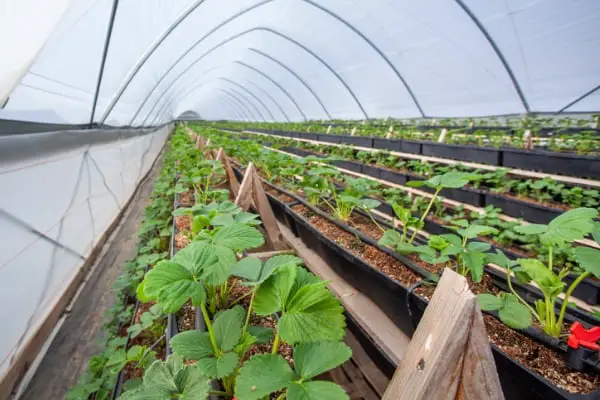
If there’s one thing the pandemic has taught us, it’s that it’s better to have a means by which you can sustain yourself.
For months, many of us have been limited to going to groceries or markets to buy food.
Those who have prepared themselves ahead are able to sustain their own pantries with fruits, veggies, spices, and herbs grown from the backyard.
A lot of people easily get intimidated by the idea of running their own self-sustaining mini-farm in their backyard.
In truth, you don’t need fancy equipment or a large plot of land to maintain a sustainable source of produce.
All you need is a greenhouse kit and you’ll be good to go. Let’s get to the basics first though,
Quick Navigation
What Is A Greenhouse?
A greenhouse is an outdoor enclosure that’s usually made of glass. This is where you can plant your own crops, flowers, or whatever kind of plant-life you choose to take care of.
It’s not a farm that you have to till and sweat for. Greenhouses are easier to maintain and are less costly as well as you don’t need heavy-duty equipment to get things going.
Greenhouses can come in all shapes and sizes. Greenhouse kits are smaller variations that help you set up a source of produce at the comfort of your home.
These kits can help you get a jumpstart on the growing season. Other than that, it gives you access to produce that’s free from pesticides and other unnatural supplements.
You might be interested in getting a greenhouse now because of what we’ve said but you need to learn more about it first.
Though easy to maintain, greenhouses will seek your nurturing and attention at the same time. Greenhouses are a science and how they work is a little more complex than you think.
How Does It Work?

Let’s first start with the basics. What do plants need to grow? They need key ingredients: light, warmth, air, water, and nutrients.
Right off the bat, we’ll say to you that a greenhouse will not provide all of these for your plants.
What it does provide is a sustainable means to regular light and warmth. Love To Know details how the magic behind greenhouses works.
The process begins when sunlight is absorbed by the translucent material that makes up the walls of the greenhouse.
The heat gets regulated and trip, allowing it to circulate in the greenhouse to provide warmth to the plants. Of course, the light passes through the glass for the plants as well.
As the heat circulates in the enclosed area, it generates an effect called the greenhouse effect.
You might have heard of this before as it’s what’s happening to the heat that gets trapped within our atmosphere which causes global warming.
To prevent the plants from getting too hot, greenhouses also need proper ventilation as well.
The warmth and light that’s provided to the plants through the greenhouse help promote photosynthesis, thus allowing the plants to grow naturally.
On your end, you’ll need to regularly water the plants and give them nutrients as well. From there, you’ll have a thriving and sustainable greenhouse ahead of you.
Getting Your Own Greenhouse Kit
Greenhouses can be as large as you want them to be but understandably, not everyone has enough space in their backyard for a large one.
As such, greenhouse kits serve as a smaller and more manageable means for you to grow your own crops and produce. You’ll still need to prepare before getting a kit started though.
One of the first things you need to think of is whether or not the space you have in your backyard is enough for the greenhouse you are planning.
That means you also need to consider the type of greenhouse you want to have. You can learn more at Harper's Nurseries about these. Some greenhouses are as small as a shed!
A good greenhouse type if you have limited space is a lean-to greenhouse. For this type, you don’t need to build four walls to lay the foundations for the greenhouse.
Instead, you only need one sturdy wall to build the greenhouse in. This could be the wall of the house or the garage.
As per Planet Natural, a disadvantage to this is that sunlight is only limited to these three walls.
Another type is called freestanding. Simply put, these are greenhouses that you build separately.
One advantage to these is that you can place them wherever you see fit. Another advantage is that freestanding greenhouses can absorb sunlight from four sides instead of three.
The next thing you need to think of is whether or not the place you are planning on gets adequate sunlight.
Keep in mind that greenhouses are supposed to have their time under the sun. If they don’t get enough heat to trap within the enclosure, then your plants are going to die very quickly.
With your greenhouse built, the next thing you need to think about is the accessories that you want your little garden to have.
One of the things you should invest in first is events. These will prevent your greenhouses from overheating. It’s a must, especially during those intense summer seasons.
Another issue you’ll face is pests. As much as possible, you don’t want to use pesticides in such an enclosed space as it could be dangerous for you and the plants.
Before you begin placing the plants inside, make sure to inspect them beforehand as there could already be some bugs and pests residing in them.
If you are building around the yard, make sure to inspect the surrounding area as well. You might not notice it at first but there could already be some pests and bugs residing on the grass.
A greenhouse could be the next best addition you can add to your home. There’s nothing better than being able to live from and care for your own crops.
Not only are you guaranteed fresh produce, but you are also guaranteed that the veggies and fruits you are eating are as clean and as natural as possible.
